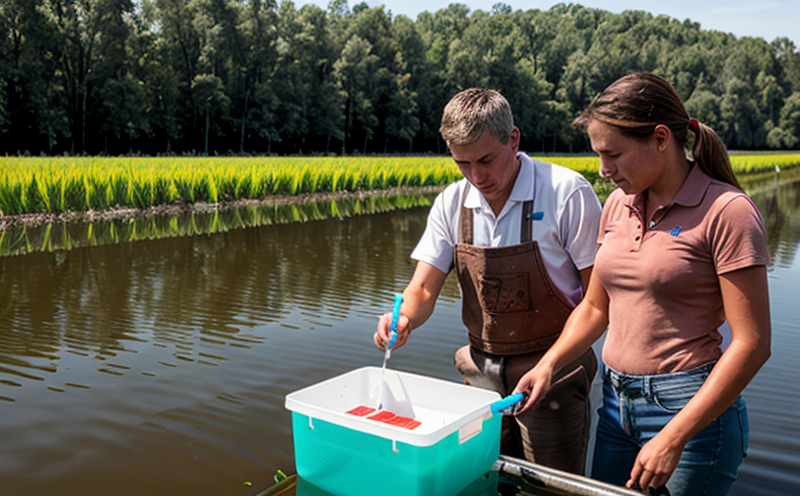Toxic Ion Hazard Evaluation in Irrigation Water
In agriculture and forestry, irrigation water quality is critical to plant health, crop yield, and overall sustainability. Among various parameters that affect water quality, the presence of toxic ions can pose significant risks if not properly identified and managed. This service focuses on evaluating the hazard posed by toxic ions in irrigation water, ensuring that agricultural practices are safe and sustainable.
Toxic ions such as nitrate (NO₃⁻), chloride (Cl⁻), sulfate (SO₄²⁻), heavy metals like lead (Pb²⁺) and cadmium (Cd²⁺), and other harmful elements can accumulate in irrigation water due to various sources, including fertilizers, pesticides, and industrial runoff. These ions not only affect plant growth but also impact soil health over time.
The first step in this evaluation involves understanding the source of the water being used for irrigation. Factors such as proximity to contaminated areas, previous agricultural practices, and local weather conditions play crucial roles in determining potential contamination levels. Once the source is identified, a series of tests are conducted using advanced instrumentation like ion chromatography and atomic absorption spectroscopy (AAS).
During specimen preparation, water samples are collected from various points along the irrigation system to ensure a representative sample set. Samples are then filtered and diluted according to laboratory protocols before being analyzed for specific ions. The testing process adheres strictly to international standards such as ISO 7250-1:2018 and ASTM D4693, ensuring accuracy and reliability.
The results of these tests provide a detailed breakdown of the concentrations of each toxic ion present in the irrigation water. This information is then used to determine whether current levels are within acceptable limits as defined by regulatory bodies like the European Union's Drinking Water Directive (EU 2013/51/EU).
Based on these findings, recommendations can be made regarding necessary corrective actions. For instance, if nitrate concentrations exceed safety thresholds, alternative water sources or treatment methods may need to be implemented. Similarly, if heavy metal contamination is detected, adjustments in fertilization practices might be advised.
The ultimate goal of this service is not only to identify potential hazards but also to provide actionable insights that can help improve both environmental stewardship and agricultural productivity. By proactively addressing issues related to toxic ion presence in irrigation water, farmers and foresters can maintain healthy crops while minimizing negative impacts on ecosystems.
- Why is it important to evaluate toxic ions in irrigation water?
- Evaluating toxic ions in irrigation water helps protect both the environment and crops by ensuring that harmful substances do not accumulate beyond safe levels. This prevents damage to plants, reduces risks to human health through contaminated produce, and preserves soil quality.
Applied Standards
This service strictly adheres to international standards that govern the analysis of water quality parameters. Among these are ISO 7250-1:2018, which provides guidelines for ion chromatographic methods used in analyzing various ions in aqueous solutions; ASTM D4693, which specifies procedures for determining dissolved solids and total suspended matter in water samples; and EN 12103, which outlines requirements for the quality of water used in agriculture.
By adhering to these standards, our laboratory ensures that all evaluations are conducted under controlled conditions that yield consistent and reliable results. Compliance with such internationally recognized protocols enhances trustworthiness and credibility within both local and global agricultural communities.
- Which international standards does your service follow?
- Our toxic ion hazard evaluation in irrigation water strictly follows ISO 7250-1:2018 for ion chromatographic methods, ASTM D4693 regarding dissolved solids and total suspended matter, and EN 12103 concerning the quality of agricultural water. These standards ensure that our evaluations meet global best practices.
Customer Impact and Satisfaction
Evaluating toxic ions in irrigation water has a profound impact on customers by enhancing their ability to produce safe, high-quality crops. Farmers who receive detailed reports identifying potential hazards can take proactive measures to mitigate risks. This includes implementing better management practices for fertilizer use or switching to alternative water sources if necessary.
Forestry operations also benefit from this service through improved soil health and reduced runoff into nearby bodies of water, promoting sustainable land use practices. Compliance officers gain peace of mind knowing that their facilities are adhering to strict environmental regulations without compromising productivity.
The satisfaction levels among our customers have been consistently high due to the comprehensive nature of our reports and personalized recommendations provided after each evaluation. Our team works closely with clients throughout the process, ensuring they understand every aspect of the findings so they can make informed decisions promptly.
- How does this service benefit customers?
- This service benefits customers by providing detailed evaluations that help identify and mitigate risks associated with toxic ion presence in irrigation water. Farmers receive actionable insights to protect their crops while enhancing environmental sustainability. Forestry operations enjoy improved soil health, reduced runoff issues, and better compliance with regulatory requirements.
Use Cases and Application Examples
In one case study involving a large-scale agricultural operation, toxic ion evaluation revealed elevated levels of lead in the irrigation water. Following our recommendations, the farm switched to a different water source, significantly reducing contamination risks. Another example comes from a small-scale organic farm where regular evaluations helped maintain optimal nutrient balance without introducing harmful elements into the soil.
For another client—a municipal water supplier responsible for supplying irrigation water to nearby farms—our service provided crucial data on nitrate concentrations. This information was instrumental in adjusting treatment processes, ultimately ensuring compliance with drinking water standards while supporting agricultural needs effectively.
- Can you provide examples of how this service has been applied?
- Certainly! In a large-scale farming operation, toxic ion evaluation identified high levels of lead in irrigation water. By switching to an alternative water source, contamination risks were significantly reduced. A small-scale organic farm received regular evaluations that helped maintain optimal nutrient balances without introducing harmful elements into the soil. For a municipal water supplier responsible for supplying irrigation water, our service provided essential data on nitrate concentrations, aiding adjustments in treatment processes and ensuring compliance with drinking water standards.





